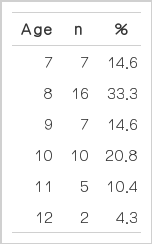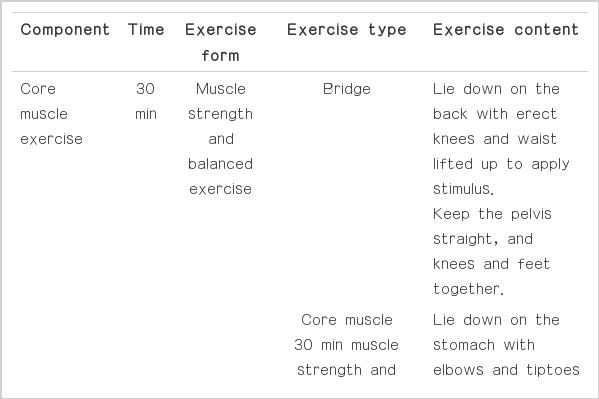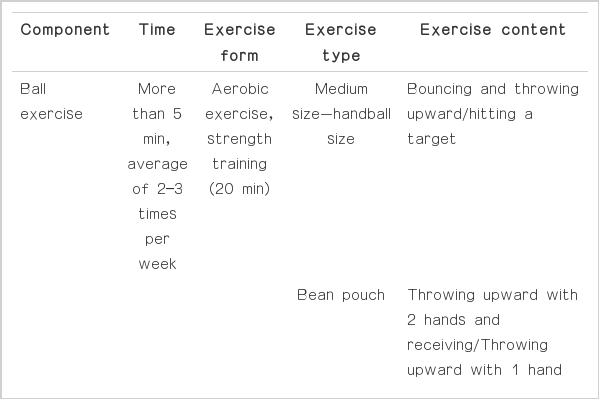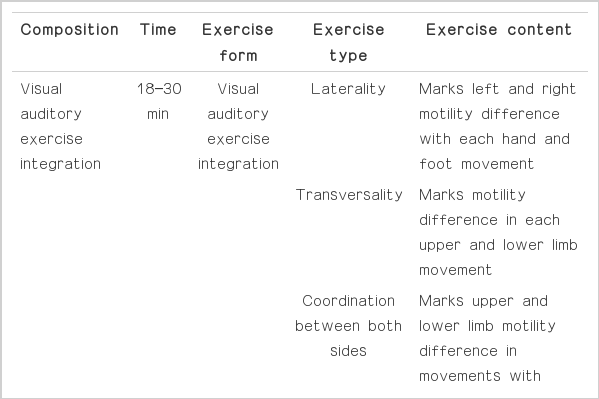Effect of complex treatment using visual and auditory stimuli on the symptoms of attention deficit/hyperactivity disorder in children
Article information
Abstract
We investigated the effects of complex treatment using visual and auditory stimuli on the symptoms of attention deficit/hyperactivity disorder (ADHD) in children. Forty-seven male children (7–13 yr old), who were clinically diagnosed with ADHD at the Balance Brain Center in Seoul, Korea, were included in this study. The complex treatment consisted of visual and auditory stimuli, core muscle exercise, targeting ball exercise, ocular motor exercise, and visual motor integration. All subjects completed the complex treatment for 60 min/day, 2–3 times/week for more than 12 weeks. Data regarding visual and auditory reaction time and cognitive function were obtained using the Neurosync program, Stroop Color-Word Test, and test of nonverbal intelligence (TONI) at pre- and post-treatment. The complex treatment significantly decreased the total reaction time, while it increased the number of combo actions on visual and auditory stimuli (P< 0.05). The Stroop color, word, and color-word scores were significantly increased at post-treatment compared to the scores at pretreatment (P< 0.05). There was no significant change in the TONI scores, although a tendency toward an increase in these scores was observed. In conclusion, complex treatment using visual and auditory stimuli alleviated the symptoms of ADHD and improved cognitive function in children. In addition, visual and auditory function might be possible indicators for demonstrating effective ADHD intervention.
INTRODUCTION
Attention deficit/hyperactivity disorder (ADHD) is a cognitive disorder that begins in childhood and continues into adulthood (Biederman, 2005); its main symptoms include attention deficit, hyperactivity, and impulsivity. These symptoms are scarcely noticeable in preschool-aged children, but they typically become apparent when children begin school and are confronted with a structured lifestyle and organized learning. ADHD is an important societal issue because children with this disorder tend to show low academic achievement and worsened relationships with peers, parents, and teachers. Additionally, they are likely to carry these problems into adulthood, and personality disorders, antisocial behaviors, drug abuse, and low self-esteem have been reported in adults with ADHD (Barkley et al., 1992; Ryu, 1996; Silver, 1992).
ADHD has recently been in the spotlight because its prevalence is gradually increasing on a large scale. Approximately 3–7% of school-aged children have ADHD abroad (American Psychiatric Association, 1994), and 5.7% of Korean children have ADHD according to the study of Im and Cho (2004), although this rate may be as high as 13.25% according to the epidemiological report on prevalence rate of children and adolescent’s mental disorder in Seoul (Seoul Child Adolescent Mental Health Center, 2005). Nevertheless, the overall ADHD prevalence rate in Korean children is over 5%.
One of the accepted hypotheses for ADHD occurrence is decreased function in the frontal lobe of the cerebrum. In other words, ADHD children have decreased basic motor skills such as balance, coordination, muscle strength, reaction time, and attentiveness (Greenhill, 2006). These children show subaverage brain function and reduced blood flow to the brain on brainwave tests, manifested as a significant drop in metabolic function in the frontal lobe of the cerebrum that controls movement and attentiveness (Korean Academy of Medical Sciences, 2008). Thus, developmental coordination disorders that include attention deficit, hyperactivity, and impulsivity (Huh, 2004) manifest, and various attempts and studies have been conducted to prevent or alleviate the main symptoms and secondary problems of ADHD children before they become serious or habitual.
Clinical ADHD treatment consists of the administration of stimulants such as amphetamine or methylphenidate (Ritalin®) that increase neurotransmitter activity by promoting dopamine or noradrenaline secretion and blocking reuptake (Arnsten, 2006). However, medication only alleviates the symptoms of ADHD instead of treating it directly (Volkow et al., 1998), and side effects such as loss of appetite, insomnia, emotional instability, headache, abdominal pain, and dizziness can occur in cases of prolonged medication (Samuels et al., 2006), thus it is not an effective long-term ADHD treatment strategy.
Therefore, many researchers have used various nonmedication supplemental methods such as behavior modification treatment (Barkley, 1998), cognition-behavioral treatment (Kendall and Braswell, 1982), fine arts, reading, play psychotherapy (Choi, 2012), and recently, occupational therapy, sensory integration, sports (Shaffer et al., 2001), or counseling programs to enhance social skills or attentiveness (Jeh, 2003). Additionally, methods to improve interaction between parents and children have been attempted (Seipp and Johnston, 2005). Among such methods, particularly physical activity, play, and sports are reported to be helpful for improving ADHD symptoms in children by increasing the frontal lobe blood flow and brainwave alertness level (Kim and Jang, 2001; Kim and Kim, 2008).
However, medication remains the dominant treatment method for improving ADHD symptoms despite previous research on nonmedication methods. This is because there is no direct method to assess whether the various physical activity-based interventions have effects that are equivalent to clinical treatment. A previous study reported marked differences in visual/auditory reactions between children with ADHD and normal children (Bedi, 1994), suggesting the possibility of using such abnormal visual/auditory reactions as an effective variable. Until now, however, they have not been considered as prime variables to assess treatment methods for ADHD symptom improvement or the effects of intervention methods. It is unclear why visual/auditory reactions have not been actively used, but this may be associated with technical and financial limitations at the time of research. Therefore, the present study intended to verify the possibility that visual/auditory stimuli might improve ADHD symptoms. The study investigated the effects of a complex treatment program using visual/auditory stimuli on the attention deficit/hyperactivity, cognitive functions, and nonverbal intelligence of ADHD children, as well as the possibility that visual/auditory reactions might be a main indicator of ADHD treatment effects in children.
MATERIALS AND METHODS
Subjects
Conner’s Rating Scale was used to assess male children aged 7–12 yr who visited B center in Seoul, Korea, and complex visual auditory treatments were implemented for 3 months after obtaining consent from the parents whose children with a total score of 18 points or higher. Children with a history of mental retardation and other mental problems, neurological disorders, or medication problems were excluded. As a result, a total of 47 male children were included in this study. The subjects’ age distribution is shown in Table 1.
Measurements
Korean version of Conner’s Rating Scale
Conner’s Rating Scale is a tool that was developed to identify ADHD children and evaluate ADHD treatment effects. Shin et al. (2005) developed a Korean version by examining the validity and reliability of IOWA Conners Rating Scale (Loney and Milich, 1982) and rendering it appropriate for use in Korea. It consists of “carelessness/hyperactivity” and “hostility/defiance” subscales, and each subscale is composed of 5 questions, with 10 questions in total. Each question is measured on a 4-point scale of “not at all true,” “not very true,” “somewhat true,” and “very true,” quantified from 0 points for “not at all true” to 3 points for “very true” to calculate the points for each subscale and the total points. This study used only the 5 subscale questions that measure “carelessness/hyperactivity” out of the entire test kit on a 4-point scale.
Visual and auditory stimuli program: Neurosync
Neurosync is a program that is designed to activate the information processing ability of the brain through exercise-related games and to strengthen the visual/auditory information processing ability, visual/auditory/touch recognition function, movement execution ability, and balance control ability, etc., through an effort to partially integrate a large amount of information. In addition, this program involves neural plasticity alterations induced by efficient control of motor planning, rhythm, sensory integration, and by providing continuous visual/auditory stimuli, thus enhancing cognitive functions such as motor skills, concentration, and information processing speed. Ultimately, the brain’s motor reaction time toward visual/auditory stimuli can be examined using this program (Neurosync Version 1.0, Think Up, Inc.).
Stroop Color-Word Test
This test was designed by Stroop, an American experimental psychologist, to study the interference phenomenon between reading colors and their names in 1935. This neurocognitive function test was further developed by Golden and Freshwater (2003) to evaluate the efficiency of the inhibitory process of the frontal lobe. It can measure the relative dominance of the language/reading system in children. The test measures the time needed to read the words and state the color of the words when the color of the words and their letters do not match. This test can be used for ADHD children to evaluate the slowed reaction time that reflects the frontal lobe’s inhibitory process (Dempster, 1981).
Test of nonverbal intelligence (TONI)
TONI is designed to measure the intelligence of preschoolers and illiterate, language-disabled, elderly, and foreign individuals. It measures the temporal and spatial ability or the actual execution ability using tests such as completing figures and pictures, assembling models with blocks, arranging pictures in the order of events, and putting puzzle pieces together, etc.
Experimental procedure
The experimental procedure and content by stage of this study is shown in Fig. 1.
Complex treatment using visual and auditory stimuli
The complex treatment was composed of core muscle, ball, eye, visual, and auditory exercise integration programs. It was developed by an expert clinical group based on effective nonmedication treatments for ADHD children suggested by previous research.
Core muscle exercise program
To strengthen the core muscles that are most important in brain development, this program was composed of isometric exercise that strengthens the core of the body, balance, and muscle endurance (Table 2).
Targeting ball exercise program
This exercise was composed of programs that stimulate the frontal lobe by movements that analyze visual information stimuli and connect to motor reactions while attempting to accurately hit a target (Table 3).
Ocular motor exercise program
The visual recognition information processing improvement computer program was used to resolve the problems of continuous and involuntary eye movements and vision-motor control in ADHD children (Table 4).
Visual auditory motor integration program
This program consisted of planned and regular exercises that measured visual and auditory motor reactivity to train the frontal lobe, basal ganglia, and the cerebellum through sensory integration exercises (Table 5).
Statistical analysis
The collected data were analyzed using the Statistical Package for the Social Sciences (SPSS) 12.0 program. Matching sample T-tests were conducted to assess differences in attention/hyperactivity, cognitive ability, and nonverbal intelligence data before and after visual/auditory complex treatment. All results represent the mean±standard deviation, and statistical significance level was set at α=.05.
RESULTS
Changes in visual reaction time and combo action number before and after complex treatment using visual/auditory senses
ADHD children’s change in visual reaction time and combo action associated with complex treatment using visual/auditory senses is shown in Fig. 2. The early reaction time to visual stimuli decreased significantly, from 95.85±33.06 ms pre-treatment to 78.80±33.98 ms post-treatment (T=2.473, P<0.017, Fig. 2A). The late reaction time to visual stimuli decreased significantly, from 84.87±27.97 ms pre-treatment to 61.46±31.71 ms post-treatment(T=3.908, P<0.001, Fig. 2B). The mean visual reaction time decreased significantly, from 114.77±31.52 ms pre-treatment to 92.42±33.51 ms post-treatment (T=4.174, P<0.001, Fig. 2C). The number of combo actions (visual stimuli reaction time below 15 ms) increased significantly, from 23.61±10.68 pre-treatment to 41.72±15.93 post-treatment (T=−7.024, P< 0.001, Fig. 2D).
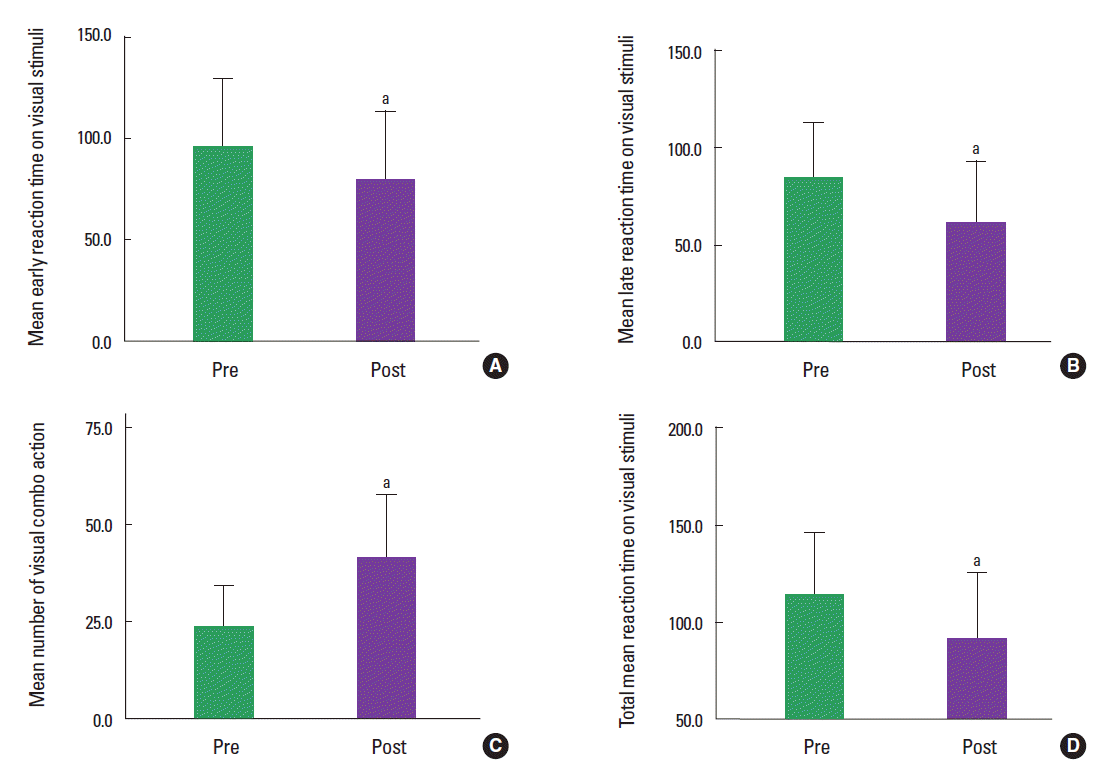
Changes in visual stimuli reaction time and the number of visual combo actions in children with attention deficit/hyperactivity disorder (ADHD). (A) mean early reaction time to visual stimuli; (B) mean late reaction time to visual stimuli; (C) total mean reaction time to visual stimuli; (D) mean number of visual combo actions. Complex treatment significantly decreased the mean early (T= 2.473, P< 0.017, A), late (T= 3.908, P< 0.001, B), and total reaction times (T= 4.174, P< 0.001, C) to visual stimuli, and increased the mean number of visual combo actions (T= −7.024, P< 0.001, D) compared to the pre-treatment values. Data are presented as the mean± standard deviation. a)P< 0.05. Pre, before complex treatment; Post, after complex treatment. Time units, ms.
Changes in auditory reaction time and combo action number before and after complex treatment using visual/ auditory senses
The changes in the ADHD children’s auditory reaction time and combo action before and after complex treatment using visual/auditory senses are shown in Fig. 3. The early reaction time to auditory stimuli decreased significantly, from 63.42±42.61 ms pre-treatment to 25.59±19.93 ms post-treatment (T=5.544, P< 0.001, Fig. 3A). The late reaction time to auditory stimuli decreased significantly, from 48.57±40.89 ms pre-treatment to 17.31±20.78 ms post-treatment (T=5.181, P<0.001, Fig. 3B). The mean auditory reaction time decreased significantly, from 78.32±35.38 ms pre-treatment to 46.09±16.16 ms post-treatment (T=6.093, P<0.001, Fig. 3C). The number of combo actions (auditory stimuli reaction time below 15 ms) increased significantly, from 49.04±20.18 pre-treatment to 90.65±27.57 post-treatment (T=−8.918, P<0.001, Fig. 3D).
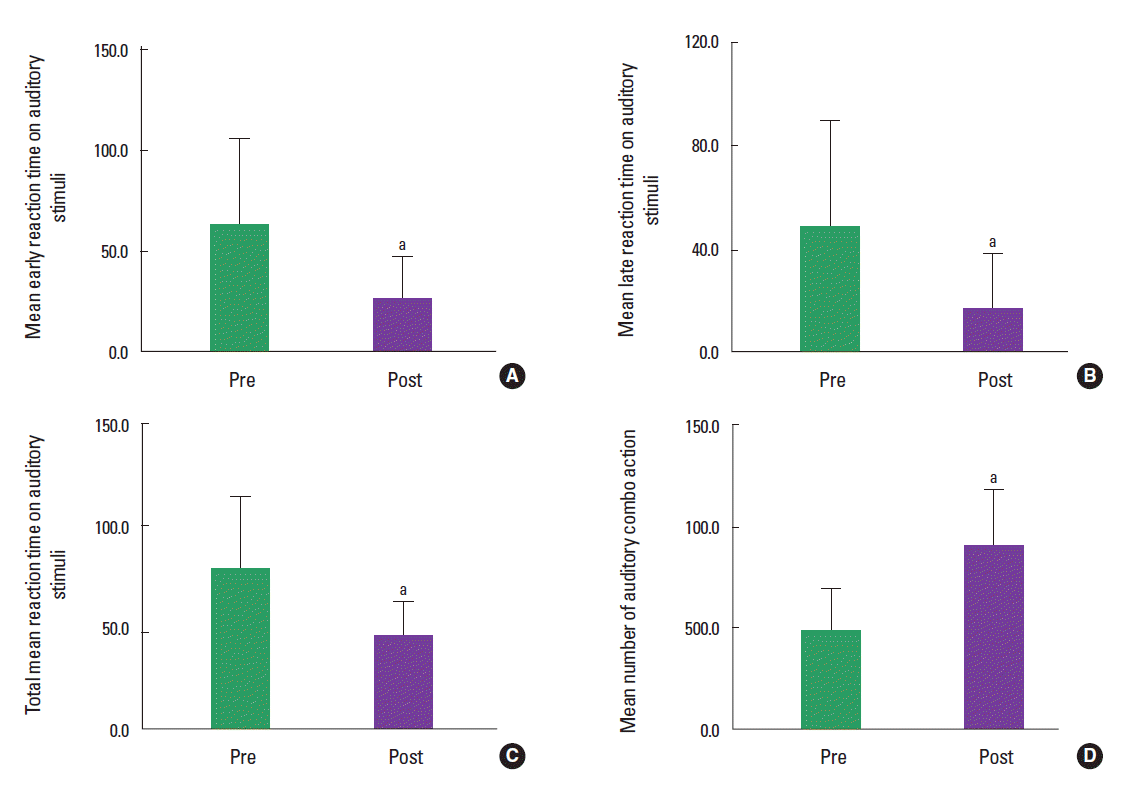
Changes in auditory stimuli reaction time and the number of auditory combo actions in children with attention deficit/hyperactivity disorder (ADHD). (A) mean early reaction time to auditory stimuli; (B) mean late reaction time to auditory stimuli; (C) total mean reaction time to auditory stimuli; (D) mean number of auditory combo actions. Complex treatment significantly decreased the mean early (T= 5.544, P< 0.001, A), late (T= 5.181, P< 0.001, B), and total reaction time (T= 6.093, P< 0.001, C) to auditory stimuli, and increased the mean number of auditory combo actions (T= −8.918, P< 0.001, D) compared to the pre-treatment values. Data are presented as the mean± standard deviation. a)P< 0.05. Pre, before complex treatment; Post, after complex treatment. Time units, ms.
Changes in Stroop Color-Word score before and after complex treatment using visual/auditory senses
The changes in the ADHD childrens’ word, color, and color-word Stroop Test scores before and after visual/auditory complex treatment are shown in Fig. 3. The word score was 45.82±9.66 before complex treatment and 49.72±11.22 after treatment (T= −3.720, P<0.001, Fig. 4A). The color score was 46.70±10.07 before complex treatment and 51.44±11.26 after treatment (T= −4.78, P<0.001, Fig. 4B). The color-word score was 43.82±8.03 pre-treatment and 49.82±10.12 post-treatment (T=−5.60, P< 0.001, Fig. 4C). After treatment, the word, color, and word-color scores increased significantly compared to the baseline scores.

Changes in the word, color, and color-word Stroop Test scores in children with attention deficit/hyperactivity disorder (ADHD). (A) word score on Stoop Test; (B) color score on Stoop Test; (C) color-word score on Stoop Test. Complex treatment significantly increased the word (T= −3.72, P< 0.001. A), color (T= −4.78, P< 0.001, B), and color-word Stroop Test scores (T= −3.72, P< 0.001. C) compared to the pre-treatment scores. Data are presented as the mean± standard deviation. a)P< 0.001. Pre, before complex treatment; Post, after complex treatment.
Changes in nonverbal intelligence scores before and after complex treatment using visual/auditory senses
The changes in the ADHD children’s non-verbal intelligence scores following visual/auditory complex treatment are shown in Fig. 5. The mean TONI score was 21.36±6.38 before the complex treatment and 22.86±7.24 after treatment. Although this change showed a trend toward an increase post-treatment, this difference was not statistically significant (T=−1.77, P=0.08, Fig. 5).
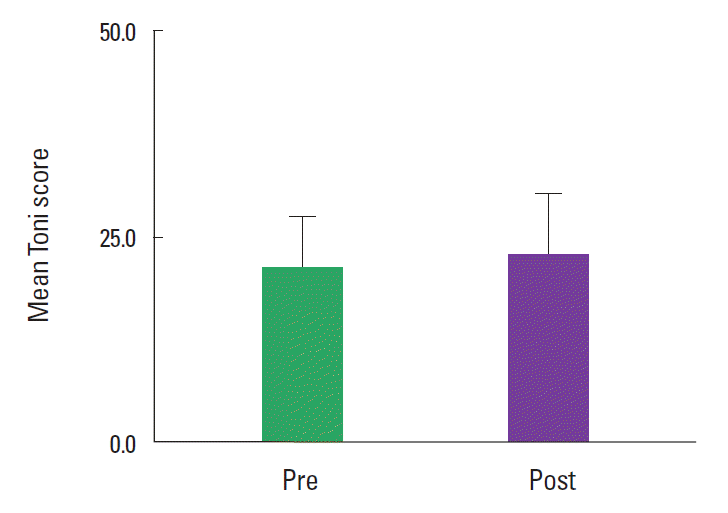
Changes in the test of non-verbal intelligence (TONI) scores before and after complex treatment in children with attention deficit/hyperactivity disorder (ADHD). Complex treatment showed a tendency toward an increase in mean TONI scores compared to the pre-treatment scores, although the difference was not statistically significant (T= −1.77, P< 0.08). Data are presented as the mean± standard deviation. P< 0.05. Pre, before complex treatment; Post, after complex treatment.
DISCUSSION
This study evaluated the effects of visual/auditory complex treatment on the improvement of problematic behaviors and cognitive functions in children with ADHD.
The present results showed that the ADHD childrens’ Stroop and non-verbal intelligence test scores were significantly lower than those of normal children. This finding supports previous reports that ADHD children show lower execution rates in executive function tests such as Stroop test (Song, 2009) and significantly lower intelligence quotient (IQ) scores compared to those for normal children (Kim and Kim, 2004; Kim and Oh, 1997). The most important result of this study is that the visual and auditory reaction time, combo action number, and Stroop color-word scores of ADHD children were significantly increased when visual/auditory complex treatments were administered. In previous studies, movement-based activities positively affected subjects’ ability to control their emotions and changes in feelings (Kim, 2010) by increasing blood flow in the frontal lobe and the brain alertness level (Kim and Jang, 2001). In school-aged children, physical activity stimulates the frontal lobe to strengthen the maintenance of attention, impulse control, and cognitive functions (Fordyce and Wehner, 1993), and play exercise improves attention, cognitive functions, social development (Ko and Kim, 2011). Moreover, similar and various methods have been studied to alleviate the symptoms of ADHD in children (Choi et al., 2010; Huh, 2004; Kwon and Chun, 2009; Lee, 2011; Yu and Kim, 2007). In other words, various physical activities such as ball exercises including movement-based activity, yoga, dancing, taekwondo, games, balancing, and jumping rope to music were suggested as effective strategies for decreasing attention deficit/hyperactivity symptoms and enhancing sociability (Hahn, 2009; Kim, 2004a, 2004b; Kim and Yu, 2010; Kwak, 2010; Lee, 2011). In particular, cognitive function improvement through physical activities in ADHD children has been reported be as effective as medication in recent studies (Medina et al., 2010). Taken together, our study results demonstrated that visual/auditory complex treatment is effective for improving non-verbal intelligence, attention, and cognitive function in ADHD children.
Previous studies showed that various intervention methods including physical activities are useful for ADHD intervention; however, the present study sought to clarify whether visual/auditory stimuli combined with physical activities are effective in ADHD children. In a previous physical program study, the attention and cognitive function of ADHD children improved by approximately 51–73% after treatment that did not involve visual and auditory stimuli (Kim, 2008; Oh, 2011), while these measures showed 62–65% improvement after visual and auditory treatment (Jung, 2010). With our program using visual and auditory senses, attentiveness and visual and auditory senses increased by approximately 79% following treatment, showing a superior effect compared to that in previous programs. Therefore, the visual/auditory complex program utilized in this study positively influenced the partial improvement of attention and cognitive function of ADHD children, and visual and auditory reactions are important indicators for evaluating ADHD children. Additionally, visual and auditory stimuli can likely be effective treatments to improve attention and cognitive function in ADHD children indirectly. However, the limitation of our study is the applicability to all subjects, as the sample size according to age was not large enough and only a limited region was targeted. Therefore, there is a need for a replication study with a larger sample size and more appropriate sampling to extend the breadth and depth of our study, compare the efficacy between visual/auditory stimuli and the existing physical programs, and clarify the responsible mechanism. Furthermore, various training programs should be developed that can effectively stimulate visual and auditory senses.
Acknowledgements
This work was supported by the National Research Foundation of Korea Grant Funded by the Korean Government (NRF-2012 S1A5B6034110).
Notes
CONFLICT OF INTEREST
No potential conflict of interest relevant to this article was reported.
